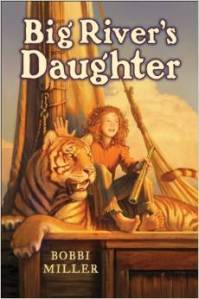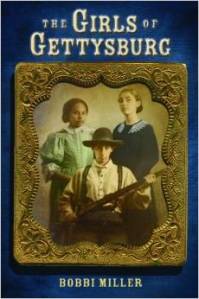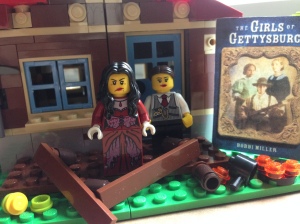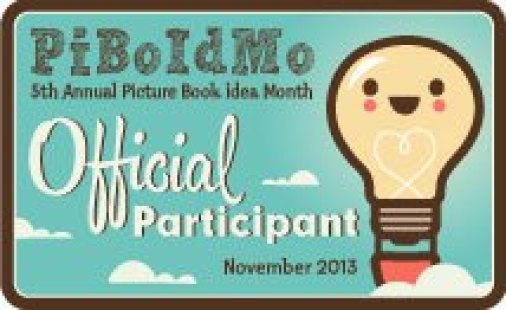 I’m honored to have award-winning historical fiction writer Bobbi Miller as my guest today. She and I have several connections that make this a special opportunity for me. We’re both graduates of Vermont College (yay!) and both are historical fiction writers. My most recent release, Grace and the Guiltless, was set in the Wild West, so Bobbi’s talk of the frontier is close to my heart.
I’m honored to have award-winning historical fiction writer Bobbi Miller as my guest today. She and I have several connections that make this a special opportunity for me. We’re both graduates of Vermont College (yay!) and both are historical fiction writers. My most recent release, Grace and the Guiltless, was set in the Wild West, so Bobbi’s talk of the frontier is close to my heart.
Bobbi’s latest book is set in Gettysburg, and I lived a short distance from there when I was in high school. We’re both also busy with the booksignings, school visits, and conference talks that go along with our 2014 book releases, so I’m extremely grateful that she found time to write such an inspiring post.
So here’s Bobbie’s wonderful advice on using history to create stories:
Growing up in the American West, I was surrounded with the bigness of everything: big sky, big mountains, epic stories about larger than life individuals. I’m also a longtime student of American history. The Frontier is one of the most significant events in American history. It marked the edge of the civilized world. Beyond that edge was the rough and tumble place full of outlaws and pirates, fanciful and alien creatures, rivers of gold and prairie seas. It was a place and life full of possible imaginations, a near incomprehensible vastness of landscape, extraordinary fertility of the land and a variety of natural “peculiarities” that inspired a humor of extravagance and exaggeration. The frontier is ripe with stories. And what intrigued me the most were the stories about the little known or the forgotten or the unexpected.
A good story makes history personal. History isn’t dull or dry, as textbooks would have us believe. It isn’t a list of dates and names, like a shopping list that no one remembers once the task is complete. History is real and relevant. The study of history, in essence, is a way of making sense of the present. As David McCullough once said, in one of my favorite quotes, “We are raising a generation of young Americans who are by-and-large historically illiterate. [But] there is literature in history.” History enlarges our understanding of the human experience, suggests Laurel Thatcher Ulrich, and as such, it needs to include the “stories that dismay as well as inspire.”
And there is no more powerful story to tell than that of the American Civil War.
As I was researching another book, I came across a small newspaper article dated from 1863. It told of a Union soldier on burial duty, following the Battle at Gettysburg, coming upon a shocking find: the body of a female Confederate soldier. It was shocking because she was disguised as a boy. At the time, everyone believed that girls were not strong enough to do any soldiering; they were too weak, too pure, too pious to be around roughhousing boys. It was against the law for girls to enlist. This girl carried no papers, so he could not identify her. She was buried in an unmarked grave. A Union general noted her presence at the bottom of his report, stating “one female (private) in rebel uniform.” The note became her epitaph. I decided I was going to write her story.
Researching this story was a daunting task because no other battle has been studied so thoroughly. I read A LOT to get these facts right. But then, there’s the emotional truth, the story behind the facts. This is the heart that belongs to Annie’s story. Historical fiction makes the facts matter to the reader. For me, the only way to discover this emotional truth was to walk the battlefield of Gettysburg, and witness that landscape where my characters lived over one hundred and fifty years ago. I walked the battlefield and talked to re-enactors and the park rangers.
I studied with the master storyteller Eric Kimmel while a graduate student at Simmons College. That tutelage continued while I was a student at VCFA, when he became my advisor. He remains to this day my Master Guru, as I call him. And, I am so very lucky and honored to call him one of my best personal friends. Likewise, I studied with Marion Dane Bauer, whose stories remain some of my all-time favorites, and I couldn’t have asked for a better teacher to show me how to find the heart of a character, or the soul of a story. The key to writing Girls of Gettysburg was finding the soul and voice to each of my three main characters.
As I began to piece the story together, I took notes. I am a great fan of purple and pink post-its. I also like anything neon colored! I outlined everything. I wrote my first drafts in longhand. I find the relationship between pen and paper much more intimate, and demands me to go deeper into the character. Then, I transferred the story to the computer. But even as I edited the manuscript, I had to print the story out, and work with pen and paper again. I use recycled paper, to be sure!
But as we know, stories tend to be organic, and sometimes outlines, research, and all the “great plans of mice and men” need to be tossed as characters take over. In which case, I tag along for the ride. Even in historical fiction, with its challenging blend of story and fact, It’s as much about story-building as it is about story-creating. Mollie Hunter explores this process in her book Talent is Not Enough in which she offers: “The child that was myself was born with a little talent, and I have worked hard, hard, hard to shape it. Yet even this could not have made me a writer, for there is no book that can tell anything worth saying unless life itself has first said it to the person who conceived that book. A philosophy has to be hammered out, a mind shaped, a spirit tempered. This is true for all of the craft. It is the basic process which must happen before literature can be created.”
Storytelling is the oldest invitation to the human experience. Stories have been told for over 100,000 years by every culture in the history of the planet. Not all cultures had a written language or codified laws, but all used stories to frame their cultural experience, history, and rituals. Heroes and heroines, like all aspects of story and myth, answered a basic human need: to explain the unexplainable. And we writers, like those ancient storytellers, are the keepers and the tellers of those “sacred” stories. Such stories do not always have a ”happily ever after.” The best stories, in fact, reflect the whole human experience. And the resolution comes because the protagonist’s choices are made when life no longer fits into her definition. Such heroines are then free to be who they need to be, and such stories empower the adolescent reader to seek, and ultimately discover, the heroine within herself.
At least, I hope my stories do.
Yes, they do! Thanks for sharing your inspiration, Bobbi! BTW, I see that your home reflects your love of the historical.
Here’s where you can find out more about Bobbi, her writing process, and her wonderful stories:
Please visit my website for more information about me and my books at: http://www.bobbimillerbooks.com/
For more about my research process, see my discussion at Donna Marie’s Peace and Poetry: http://donnamariemerritt.wordpress.com/2014/07/24/bobbi-miller-folklore-artist-extraordinaire/
Also see my discussion on Historical Fiction at Yvonne Ventresca’s blog, http://www.yvonneventresca.com/1/previous/2.html)
Holiday House, my publisher, lists where you can buy the book here: http://www.holidayhouse.com/title_display.php?ISBN=9780823431632
And I couldn’t resist adding this fun Lego promotion created for Bobbi’s book release:







This is fascinating information. I’ve enjoyed reading both books and I love seeing the author’s gorgeous log cabin!
Thank you so much for this! And don’t you just love Lyn’s LEGO Art!
Lynn’s Lego art is such a fun touch!
As a writer of historical fiction as well, I appreciate your comment about historical fiction as a means of discovering the emotional truth of an event.
Bobbi, I loved learning about your research, and the story behind the story. Thanks for sharing this interview, Laurie!
Yvonne
Thank you for dropping by, Lyn and Yvonne! This is a subject near and dear to all our hearts, it seems!
“Historical fiction makes the facts matter to the reader.” Yes!
I’m also drawn to the Frontier and it’s various locations and time periods. That moving boundary always meant strong people struggling to survive–the makings of great stories.
So very true, Debbie!